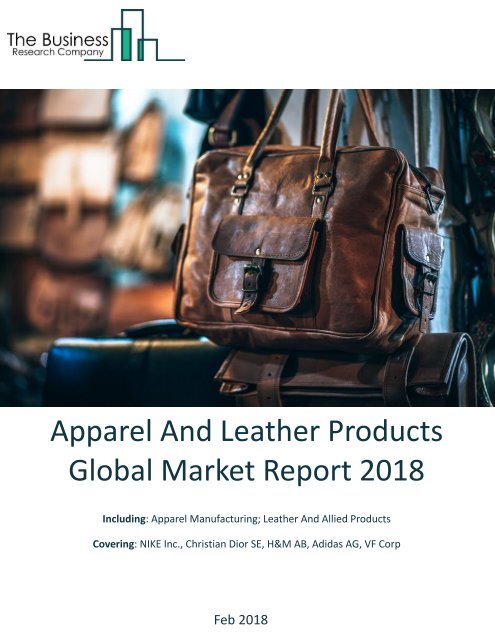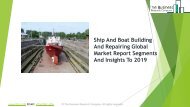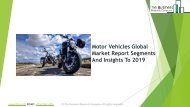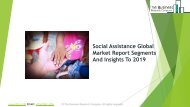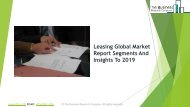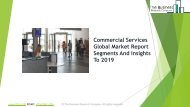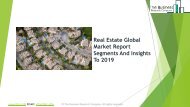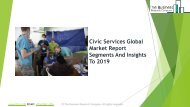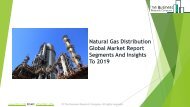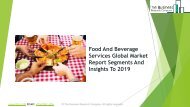Apparel And Leather Products Global Market Report 2018
Asia Pacific was the largest region in the apparel and leather products market in 2017, accounting for 40% market share. The USA was the largest country in the market in 2017, accounting for 20% market share. Read Report https://www.thebusinessresearchcompany.com/report/apparel-and-leather-products-global-market-report-2018
Asia Pacific was the largest region in the apparel and leather products market in 2017, accounting for 40% market share. The USA was the largest country in the market in 2017, accounting for 20% market share.
Read Report
https://www.thebusinessresearchcompany.com/report/apparel-and-leather-products-global-market-report-2018
You also want an ePaper? Increase the reach of your titles
YUMPU automatically turns print PDFs into web optimized ePapers that Google loves.
<strong>Apparel</strong> <strong>And</strong> <strong>Leather</strong> <strong>Products</strong><br />
<strong>Global</strong> <strong>Market</strong> <strong>Report</strong> <strong>2018</strong><br />
Including: <strong>Apparel</strong> Manufacturing; <strong>Leather</strong> <strong>And</strong> Allied <strong>Products</strong><br />
Covering: NIKE Inc., Christian Dior SE, H&M AB, Adidas AG, VF Corp<br />
Feb <strong>2018</strong>
Reasons to Purchase<br />
• Outperform competitors using accurate up to date demand-side dynamics<br />
information.<br />
• Identify growth segments for investment.<br />
• Facilitate decision making on the basis of historic and forecast data and the<br />
drivers and restraints on the market.<br />
• Create regional and country strategies on the basis of local data and analysis.<br />
• Stay abreast of the latest customer and market research findings<br />
• Benchmark performance against key competitors.<br />
• Develop strategies based on likely future developments.<br />
• Utilize the relationships between key data sets for superior strategizing.<br />
• Suitable for supporting your internal and external presentations with reliable high<br />
quality data and analysis<br />
• Gain a global perspective on the development of the market.<br />
• <strong>Report</strong> will be updated with the latest data and delivered to you within 3-5<br />
working days of order.<br />
Scope<br />
<strong>Market</strong>s Covered: <strong>Apparel</strong> Manufacturing; <strong>Leather</strong> <strong>And</strong> Allied <strong>Products</strong><br />
Companies Mentioned: NIKE Inc., Christian Dior SE, H&M AB, Adidas AG, VF Corp<br />
Countries: Brazil, China, France, Germany, India, Italy, Japan, Spain, Russia, UK, USA and<br />
Australia.<br />
Regions: Asia-Pacific, Western Europe, Eastern Europe, North America, South America,<br />
Middle East <strong>And</strong> Africa<br />
Time series: Five years historic and forecast.<br />
Data: Ratios of market size and growth to related markets, GDP, Expenditure Per Capita,<br />
<strong>Apparel</strong> <strong>And</strong> <strong>Leather</strong> <strong>Products</strong> Indicators Comparison.<br />
Data segmentations: Country and regional historic and forecast data, market share of<br />
competitors, market segments.<br />
Sourcing and Referencing: Data and analysis throughout the report is sourced using end<br />
notes.
<strong>Apparel</strong> <strong>And</strong> <strong>Leather</strong> <strong>Products</strong><br />
<strong>Market</strong> Characteristics<br />
The apparel and leather products market comprises establishments involved in<br />
the manufacture and sale of apparel, leather and related products.<br />
The apparel and leather products in this report is segmented into apparel<br />
manufacturing and leather and allied products.<br />
<strong>Apparel</strong>s Manufacturing includes establishments engaged in manufacturing ready<br />
to wear apparel and<br />
<strong>Leather</strong> and Allied Product Manufacturing establishments are engaged in tanning<br />
or curing of hide into leather and<br />
In this report market value is defined as the revenues organizations earn by<br />
selling their goods and services within the specified market, based on the price at<br />
which they sell. Only goods and services traded between entities are included.<br />
The revenues for a specified geography are consumption values – that is, they are<br />
revenues generated by organizations in the specified geography within the<br />
specified market, irrespective of where they are produced.
<strong>Apparel</strong> <strong>And</strong> <strong>Leather</strong> <strong>Products</strong><br />
<strong>Market</strong> Historic Growth<br />
The global apparel and leather products market grew from $X billion in 2013 to $X<br />
billion in 2017 at a compound annual growth rate (CAGR) of X%.<br />
The chart and table below shows the year-on-year growth of the global apparel<br />
and leather products market during 2013 – 2017.<br />
Drivers of the <strong>Market</strong>:<br />
Restraints on the <strong>Market</strong>:
<strong>Apparel</strong> <strong>And</strong> <strong>Leather</strong> <strong>Products</strong><br />
<strong>Market</strong> Forecast Growth<br />
The global apparel and leather products market is expected to grow from $XX<br />
billion in 2017 to $1686.1 billion in 2021 at a compound annual growth rate<br />
(CAGR) of XX%.<br />
The chart and table below shows the year-on-year growth of the global apparel<br />
and leather products market during 2017 - 2021.<br />
Drivers of the <strong>Market</strong>:<br />
Restraints on the <strong>Market</strong>:
<strong>Apparel</strong> <strong>And</strong> <strong>Leather</strong> <strong>Products</strong><br />
<strong>Market</strong> Segmentation<br />
The chart and table below shows the split of the apparel and leather products<br />
market in 2017.<br />
The total market value for apparel and leather products was $X billion in 2017.<br />
The markets that are covered include <strong>Apparel</strong> Manufacturing; <strong>Leather</strong> <strong>And</strong> Allied<br />
<strong>Products</strong>.<br />
<strong>Apparel</strong> Manufacturing was the X largest segment in the apparel and leather<br />
products market with X% share of the market. The market value for the apparel<br />
manufacturing was $X billion in 2017.<br />
<strong>Leather</strong> <strong>And</strong> Allied <strong>Products</strong> was the X largest segment in the apparel and leather<br />
products market with X% share of the market. The market value for the leather<br />
and allied products was $X billion in 2017.
<strong>Apparel</strong> <strong>And</strong> <strong>Leather</strong> <strong>Products</strong><br />
<strong>Market</strong> Regional <strong>And</strong> Country<br />
Analysis<br />
The Asia Pacific was the largest region in the apparel and leather products market<br />
in 2017, apparel and leather products for $X billion or X% market share.<br />
North America was the x largest region apparel and leather products for $X billion<br />
or X% market share.<br />
Western Europe was the X largest region apparel and leather products for $X<br />
billion or X% market share.
<strong>Apparel</strong> <strong>And</strong> <strong>Leather</strong> <strong>Products</strong><br />
<strong>Market</strong> Competitive Landscape<br />
The leading competitors in the global apparel and leather products market are<br />
NIKE Inc., Christian Dior SE, H&M AB, Adidas AG, VF Corp.<br />
The chart and table below displays the percentage market share of the top<br />
players in the apparel and leather products market industry.<br />
NIKE Inc. generated revenues of $XX billion for the financial year 2016, an XX%<br />
increase from the previous year.<br />
Christian Dior SE generated revenues of $XX billion for the financial year 2016, an<br />
XX% increase from the previous year.<br />
H&M AB generated revenues of $XX billion for the financial year 2016, an XX%<br />
increase from the previous year.
Adidas AG generated revenues of $XX billion for the financial year 2016, an XX%<br />
increase from the previous year.<br />
VF Corp generated revenues of $XX billion for the financial year 2016, an XX%<br />
decrease from the previous year.<br />
Kering SA generated revenues of $XX billion for the financial year 2016, an XX%<br />
decrease from the previous year.<br />
PVH Corp. generated revenues of $XX billion for the financial year 2016, an XX%<br />
increase from the previous year.<br />
Ralph Lauren Corporation generated revenues of $XX billion for the financial year<br />
2016, an XX% decrease from the previous year.<br />
Hanesbrands Inc. generated revenues of $XX billion for the financial year 2016, an<br />
XX% increase from the previous year.<br />
Levi Strauss and Co generated revenues of $XX billion for the financial year 2016,<br />
an XX% increase from the previous year.<br />
Company Profile<br />
NIKE Inc.<br />
Overview<br />
Nike was the largest company in the global apparel and leather products<br />
market in 2017 with XX% share of the market. The company designs,<br />
develops, and markets a wide range of athletic footwear, apparel,<br />
equipment, and accessory products for men, women, and children. The<br />
company sells its products through third party retail stores and also<br />
through its own stores, subsidiaries, and distributors. NIKE, Inc. was<br />
incorporated in 1967 and is headquartered in Beaverton, Oregon, US.<br />
<strong>Products</strong> and Services<br />
The company offers its products through the following product segments:<br />
The Footwear segment is involved in the design, manufacture, and<br />
marketing of footwear. Some of the well-known brands under this
<strong>Apparel</strong> segment focuses on design, manufacture, and marketing of sports<br />
apparel. Its key products include<br />
Equipment segment sells performance equipment and accessories including<br />
Other segment focuses on design, distribution, and licensing of apparel,<br />
casual sneakers, and accessories under the<br />
Strategy<br />
Nike’s growth strategy aims at improving long-term shareholders value. In<br />
this line, Nike through strategic partnerships and agreements focuses on<br />
strengthening its position in global apparel and footwear market. In August<br />
2016, the company partnered with<br />
Financial Performance<br />
Nike, Inc. generated revenues $XX billion for the financial year 2016, an<br />
XX% increase from the previous year. The company had a market<br />
Christian Dior<br />
Overview<br />
<strong>Products</strong> and Services<br />
Strategy<br />
Financial Performance<br />
H&M AB<br />
Overview<br />
<strong>Products</strong> and Services<br />
Strategy<br />
Financial Performance<br />
Adidas AG<br />
Overview<br />
<strong>Products</strong> and Services<br />
Strategy<br />
Financial Performance
VF Corp<br />
Overview<br />
<strong>Products</strong> and Services<br />
Strategy<br />
Financial Performance


